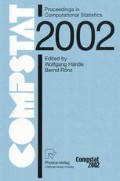Abstract
Gene expression arrays pose challenging problems for most traditional supervised learning techniques. We present a discussion of some of the issues involved. We then propose a simple approach to class prediction for DNA microarrays, based on a enhancement of the nearest centroid classifier. Our technique uses soft-thresholded class centroids as prototypes for each class. The shrinkage improves significantly prediction performance, and identifies a subset of the genes most responsible for class separation. The method performs as well or better than competitors from the literature, and is easy to understand and interpret. We illustrate the technique on data from three studies: small round blue cell tumors, leukemia and breast cancer.
Access this chapter
Tax calculation will be finalised at checkout
Purchases are for personal use only
Preview
Unable to display preview. Download preview PDF.
References
Breiman, L. (1996), ‘Bagging predictors’, Machine Learning 26, 123–140.
Donoho, D. & Johnstone, I. (1994),`Ideal spatial adaptation by wavelet shrinkage’Biometrika81,425–455
Eisen,M., Spellman,P., Brown,P.& Botstein, D.(1998), `Cluster analysis and display of genome-wide expression patterns’ Proc.Natl. Acad.Sci.USA95,14863–14868
Friedman, J.(1989), `Regularized discriminant analysis’, Journal of the American Statistical Association 84, 165–175.
Hastie, T., Tibshirani, R.& Friedman, J.(2001)The Elements of Statistical Learn- ing; Data mining Inference and Prediction, Springer Verlag, New York
Khan, J., Wei, J., Ringner, M., Saal,L., Ladanyi, M., Westermann, F., Berthold, F., Schwab, M., Antonescu, C.,Peterson, C., & Meltzer, P.(2001), ‘Classification and diagnostic prediction of cancers using gene expression profiling and artificial neural networks’Nature Medicine7, 673–679
Tibshirani, R. (1996), `Regression shrinkage and selection via the lasso’J. Royal. Statist. Soc. B. 58, 267–288.
Tibshirani, R., Hastie, T., Narasimhan, B. & Chu, G. (2002),`Diagnosis of multiple cancer types by shrunken centroids of gene expression’,Proceedings of the National Academy of Sciences
Tusher, V., Tibshirani, R & Chu, C. (2001), `Significance analysis of microarrays applied to transcriptional responses to ionizing radiation’,Proc. Natl. Acad. Sci. USA.98, 5116–5121.
Author information
Authors and Affiliations
Editor information
Editors and Affiliations
Rights and permissions
Copyright information
© 2002 Springer-Verlag Berlin Heidelberg
About this paper
Cite this paper
Hastie, T., Tibshirani, R., Narasimhan, B., Chu, G. (2002). Supervised Learning from Microarray Data. In: Härdle, W., Rönz, B. (eds) Compstat. Physica, Heidelberg. https://doi.org/10.1007/978-3-642-57489-4_7
Download citation
DOI: https://doi.org/10.1007/978-3-642-57489-4_7
Publisher Name: Physica, Heidelberg
Print ISBN: 978-3-7908-1517-7
Online ISBN: 978-3-642-57489-4
eBook Packages: Springer Book Archive

